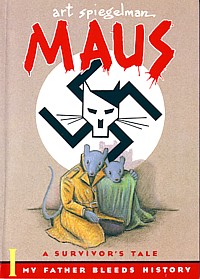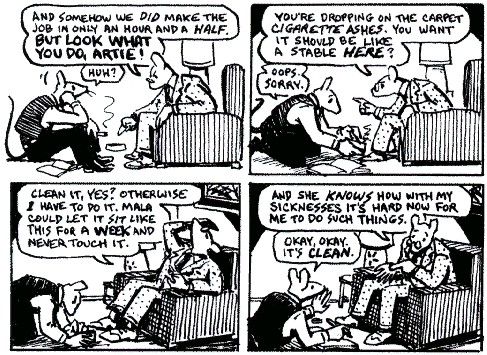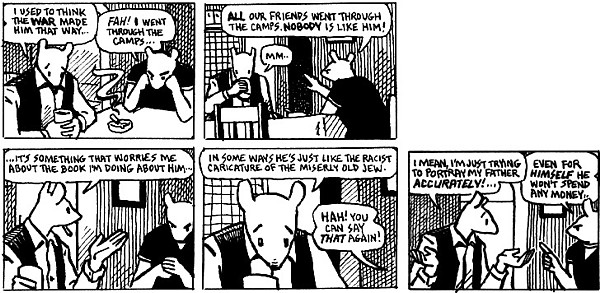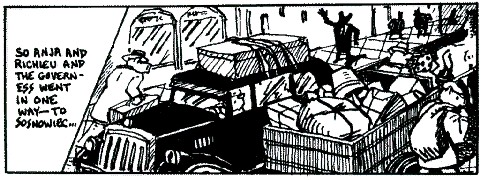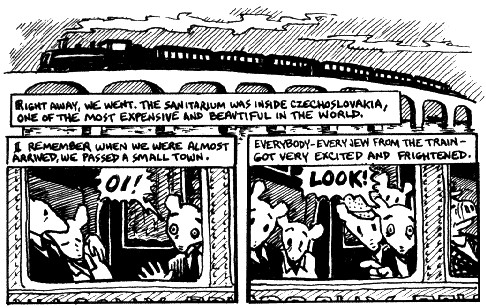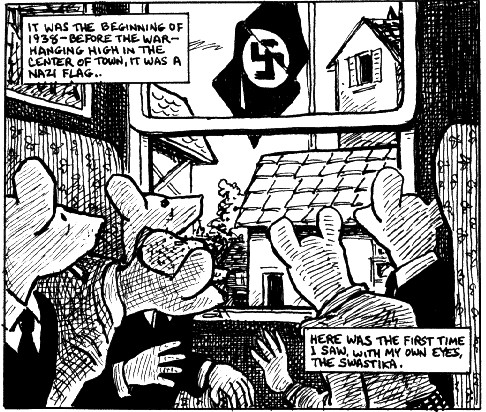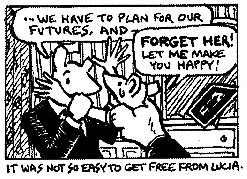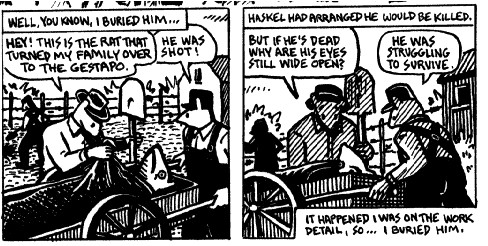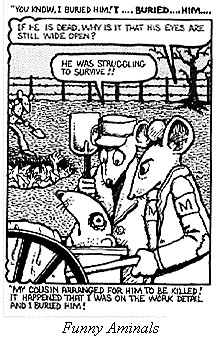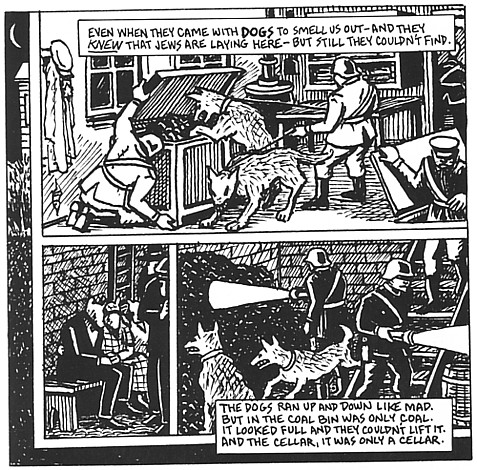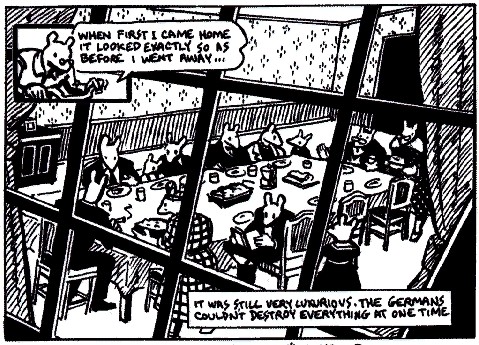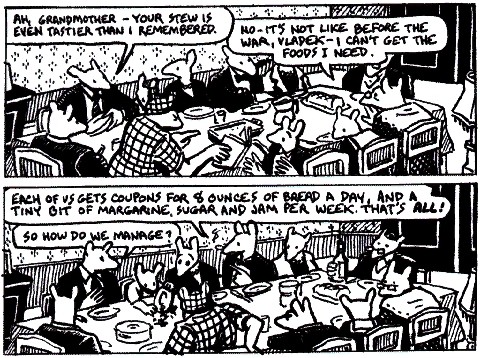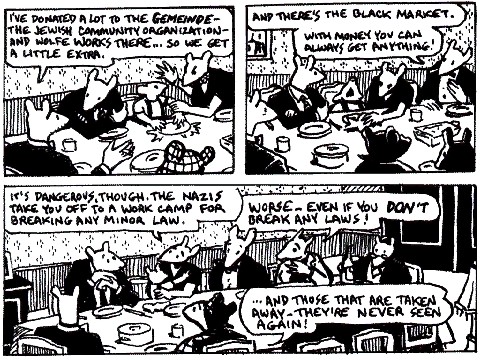|
I
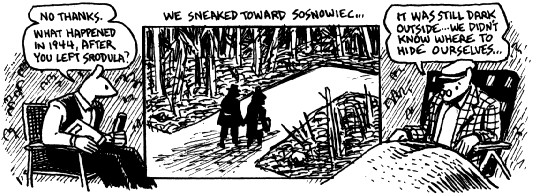
Maus is the story of two survivors of the Holocaust.
The first is Vladek Spiegelman, a Polish Jew who, along with his wife
Anja, survived Auschwitz and came to live in Queens, New York. There,
Vladek and Anja raised their second son, Art, their post-Holocaust child
(their first son died during the early stages of the Final Solution).
Art grew into adulthood under the shadows of his parents' past, the darkest
appearing in 1968 when Anja committed suicide. Art himself is the second
survivor, although at first his torment seems self-indulgent compared
to the elemental horror of his parents' experience.
The accounts of these two survivors run through Maus as Art records his
father's memories in a series of oral interviews: Vladek's courtship of
the wealthy Anja, the marriage that facilitated his rise in the business
world of the secularized Jewish community of Sosnowiec, his induction
into the Polish Army and capture by the Nazis in 1939, his release and
return to the area of Poland "annexed" by the Reich. Vladek
relates the steady tightening of the Nazi noose around the Jews as the
policies of extermination were put into practice, detailing how, as the
concentration camps filled, he and Anja managed to survive through cunning
strategies and blind luck, until they were caught and sent to Auschwitz.
Throughout Maus, Vladek's story is paralleled by Art's attempts to come
to terms with the opinionated, tight-fisted, and self-involved father
whose personality was formed in a world and through an experience so completely
divorced from his own. The ghosts of this past swirl around Art who is
haunted by the irretrievable experiences of the dead, their residue found
in familial relationships characterized by guilt and manipulation. The
first volume closes with dual betrayals: Vladek describes how he paid
two Poles to smuggle Anja and him to Hungary only to be turned over to
the Nazis; minutes later he reveals to his son that, after Anja's suicide,
he destroyed her diaries, her account of the Holocaust for which Art has
been frantically searching.
It is logical to approach the book first as a work of oral history, because
of its sources and Spiegelman's decisions about the structure of its text.
The absence of footnotes or bibliography should not be mistaken for indifference
to the importance of research. "Essentially, the root source of the
whole thing is my father's conversations with me," Spiegelman explained
when I asked him about the sources he consulted. "Sixty percent of
those are on tape and the rest of it's during phone conversations or while
I was at his house without a tape recorder, taking notes. Now, my father's
not necessarily a reliable witness and I never presumed that he was. So,
as far as I could corroborate anything he said, I did--which meant, on
occasion, talking to friends and to relatives and also doing as much reading
as I could."
Although Maus focuses on the particularity of Vladek's story,
Spiegelman succeeds, through succinct narration and dialogue, in keeping
us aware of the changing social and political climate of Sosnowiec, and
from there the context of Poland and the Third Reich. "This is a
bottomless pit of reading if one falls into the area," Spiegelman
said. "There's building after building of books and documents. I
don't pretend to [have read them all]. On the other hand . . . I read
as many survivors' accounts as I could get hold of that touched on the
specific geographical locations [depicted in the book]." In his effort
to place Vladek on the particular map of Sosnowiec, Spiegelman was also
aided by a Polish pamphlet published after the war that chronicled the
fate of the Jews of that city. "Every region had its own booklet
... [The Sosnowiec pamphlet] was really important for the things that
take place in the last half of the first volume because it has very, very
specific information."
Spiegelman's sources are relevant, but oral history is more than a verbatim
transcript propped up by corroborative facts and context. The structuring
of an account--how a recorder shapes his or her sources, how he or she
organizes the materials into an interpretive narrative--are equally a
concern. In his choices and the critical considerations behind those choices,
Spiegelman worked as a skilled oral historian. He presented his father's
story as a chronologically-linked chain of events, restructuring Vladek's
testimony to strengthen the clarity of the account. But, the way one chooses
to tell a story is a kind of censorship, and Spiegelman conscientiously
had to weigh the impact of one narrative decision over the effects of
others:
This is my father's tale. I've tried to change as little as possible.
But it's almost impossible not to [change it] because as soon as you
apply any kind of structure to material, you're in trouble--as probably
every historian learns from History 101 or whatever. Shaping means [that]
things that came out [in an interview] as shotgun facts about events
that happened in 1939, facts about things that happened in 1945, they
all have to be organized. As a result, this tends to make my father
seem more organized than he was For a while I thought maybe I should
do the book in a more Joycean way. Then I realized that, ultimately,
that was a literary fabrication just as much as using a more nineteenth
century approach to telling a story, and that it would actually get
more in the way of getting things across than a more linear approach.
Or, as Spiegelman shows more concisely in Maus:

|
